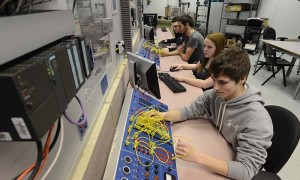One of the most asked questions by migrants moving to Australia is “How do I choose a school for my children?”. Not an easy task when you’re 10,000 miles away so let’s look at some of the things you need to consider.
Private or Public school
This comes down to personal preference and what you can afford. Both my children went through public schools in Western Australia and onto University so for me public schools have been good. Public schools are often very diverse and most draw their main body of students from the local community.
If you go private just beware that some are faith based and follow a religious curriculum with some very old fashioned values, often all girls all boys schools. They do pride themselves on sport and many operate excellent sport programs. They are generally well funded which is something you would expect considering they also receive funding from the government at the expense of public schools. A top private school can command a $30,000 fee per year so make sure you understand the impact the school fees will have on your living expenses.
Not all can afford to send their children to a top private school but don’t despair some public schools regularly beat top private schools in the school ranking tables despite the poor funding. You will need to keep in mind though that even public schools are not totally free and top public schools can command fees as much a $2,000 per year for a student in year 12. They may say voluntary contributions but if your child is to participate fully you will be expected to pay so you will need to budget for this.
Cost is one factor that will determine where we send our children to school the other factor is where we live. Most parents have to live near where they work and so this will often dictate what schools are available to you. Just remember though the quality of education is not just about results. According to the ACER (Australian Council for Educational research) chief executive Geoff Masters “The quality of education provided by a school is best judged not by its final results but by the difference it makes, taking into account students’ starting points. A school making a large difference ‘value adding’ to students’ levels of achievement and life chances may deliver ‘better education’, despite its lower Year 12 results.” So something to consider rather than just results.
Australia, like the UK, uses a league table system to compare schools. When you use it keep in mind the words of ACER Chief Executive above regarding how schools add value to student education. You can find more information on league tables and compare schools in the area you wish to move to on the myschool.edu.au website. It covers the entire education systems across Australia.
The Myschool website contains quite a large range of information on schools, covering the profile of population of each school of which there is approximately 9,500. The site also lists outcomes of NAPLAN testing performance data, student attendance and school financial figures including capital expenditure and sources of funding. It’s a good source of information and you are able to compare literacy and numeracy standards of local schools to state averages. Whilst this may give an indication of current standards it is important to consider achievements in Years 11 and 12. For example: years 7 and 9 NAPLAN tests may show the majority of students in the lower brackets of the test results. The school however has an excellent achievement rate for both ATAR (university students, more on that later) and vocational studies (non ATAR). This would suggest that the school may have an excellent system to bring those struggling students up to speed by the time they leave. A very important point to consider.
For those who are curious NAPLAN stands with the National Assessment Program – literacy and numeracy (NAPLAN) and is an annual assessment of students in years 3, 5, 7 and 9. NAPLAN has been an everyday part of the school calendar since 2008. Assessments are undertaken nationwide every year in the second full week in May. Tests are made up of four areas or domains covering:
• Reading
• Writing
• Language conventions (spelling grammar and punctuation)
• Numeracy
Now to try and explain this ATAR business which is not an easy task I might add. In short an ATAR score is a percentile score given between “less than 30” up to a maximum of 99.95 (in a minimum increment of 0.05). Clear as mud so far I guess. In layman terms it is a score which denotes a student’s ranking relative to his or her peers upon completion of their secondary education. This score is used by university and tertiary education programs to rank and select prospective students. In short the higher your ATAR score is the more university courses you have to choose from. Most universities will display minimum ATAR scores for entry to all their courses.
The School system in brief
Australia is made up of a collection of states and territories each has its own government which is responsible for its own education. Because of this there are some differences between states in the way schools operate. There is a national framework however which all schools have to follow to try and ensure some standardisation across the nation. Most states operate similar programs with primary school running from kindergarten through to year six or seven. High schools tend to run from year 7 to 10 and then senior high school runs from year 11 to year 12. The majority of schools cater for the full range from year 7 through to year 12, although there are a few specialist schools that operate just years 7 to 10 or years 11 and 12 in all states. In some states schools that operate for just year 11 and 12 are able to specialise in certain areas becoming Regional Training Organisations (RTO’s) allowing students to get involved in pre-apprenticeships.
All states offer their own certification, for example in Western Australia students achieve the Western Australian Certificate of Education at the end of year 12 (WACE). In the Eastern states the Australian Capital Territory students are awarded the ACT Certificate. In New South Wales they offer the Higher School Certificate, in Queensland it’s the Queensland Certificate of Education. In Victoria (yes, you’ve guessed it) it’s the Victorian Certificate of Education or the Victorian Certificate of Applied Learning. Moving west to South Australia they have the South Australian Certificate of Education and up in the Northern Territory its known as the Northern Territory Certificate Education.
If you are worried you may have to move states as I did rest assured that all Australian schools follow the Australian Qualifications framework (AQF) which has 10 levels and links school, vocational and university education qualifications into one national system. This does allow for some standardisation across the states and allows students to move easily from one level of study to the next, and from one institution to another. For early years there will be some differences but these will be more operational than subject content. For years 11 and 12 it may be more significant especially for university bound students as specialist areas will vary from school to school and state to state. This is also affected by availability of specialist teachers in your chosen subject area.
In my experience I have found UK school children to be slightly in front in terms of their level of education and maturity. This is certainly true in the early years however years 11 and 12 can be extremely intense especially if they have University ambitions.
Consider their in opinions?
Now many will make the assumption that when choosing a high school you should look for the best. That doesn’t always hold true as I have seen children go through private education only to drop out due to the pressure of the strict regime and work ethic, it doesn’t suit everyone. In our quest to find the best we often forget the feelings of the little guys and girls who will have to attend that institution every day. In short your children’s opinions should count as well. Some children are naturally confident and enjoy tough challenges. Others may like a more relaxed less pressured environment.
Find out what your children’s preferences are, what special talents do they have, musical, mathematical, science, sport and then find a school nearby that fits their needs. Look for the school that best fits your values and children’s needs, not just plum for the best in the areas because that is what other parents are doing. Step back assess what the school has to offer and try to figure out what’s best for your children. By doing this your child is likely to be far happier at school and so will you.
School life
The school year across Australia runs from the beginning of February through to the latter part of December. The school year is normally split into two semesters. Each semester consists of two terms each 10 week long (4 in total). At the end of each term students have a two week holiday. Summer holidays start in December and last until the beginning of February. As states look after their own education holidays can sometimes vary from state to state. You can get a full list of the holidays across Australia from http://www.australia.com
Daily school normally starts around about 8.40 am and finishes at 3.00 pm. The day is split into five periods each lasting around 60 minutes with two 20 to 25 minute breaks in between period 2 and 3 and then period 4 and 5. Extracurricular activities normally run from 3 to 4pm. Again school days will vary from state to state and in some schools they operate the split system where lower school students start at around 7am through to about 1pm. Upper school students attend later in the day and finish around about 5pm. This is only a guide and it does vary from school to school and state to state.
Just arrived
There are some who believe that children should start school as soon as you arrive to help them integrate quicker. I think that is a fair comment as it’s important to get your children integrated into Australian life as soon as possible. Having said that I feel it’s important to give children a little time to recover from their travels and get used to their new surroundings.
Some schools may allow you to preliminarily book your child into the their school before you arrive. Whilst it’s nice to know you have a school lined up in my opinion it may be in your best interests to just wait a little longer until you arrive. We gave our children a couple weeks to integrate and take in a little of the enormous change they had experienced in their lives at that point in time. It also gave us chance to visit the schools with the children in a more relaxed manner. I personally would not book my children into school before I had actually visited and checked out what it was like. Furthermore competition for places in the better schools is often tight so they can afford to be a bit choosy about who they pick especially if you live outside the catchment area. They will probably want to interview you and your children before they allow them to enrol.
Researching schools
If you can afford to come out on a reconnaissance visit before you migrate it helps. It’s a lovely way to assess areas to live in and schools as you are in a far more relaxed mood. Make sure you draw up an itinerary and a plan of where you are going to visit to ensure you give yourself enough time to have a holiday as well.
Contact the school prior to your arrival and make an appointment with the Principle to discuss your child’s proposed enrolment. Yes principles are busy people but they will appreciate that you have taken the time to make an appointment after all you want to make a good impression.
Local knowledge is often the best so get out and about, talk to the locals and get their views on the best school in the area. Visit a few schools and watch the students coming and going. Are they happy? How are they dressed? Are they all in uniform? If any of these are negative then you might to try and discuss this with locals. Yes you will need to mingle with parents and introduce yourself but be brave and ask what they think of the school you may be surprised as to what you find out
Check out the schools social media profile. Most schools have a Facebook page Twitter account or an app to download for your phone. Take a look at these as this will give you an indication as to how the school communicates with the local community. look at how parents discuss the school, do they use positive or negative tones? How does the school communicate back to the parents do they answer all the questions politely and positively.
Most schools have their own website which often contain details of the curriculum they offer to students including a plan of the year. Schools that have this facility are, in my opinion, often very organised and efficient which is good sign. Have a look and see what extracurricular activities they offer outside of school hours. Do they cater for disabilities or gifted and talented students? Remember the article above about adding value to a child’s education. If they have a newsletter sign up for it and get regular updates on what’s happening at the school.
Opinions from message boards
Last but not least the expat message boards. They are useful especially when you have honest opinions from expats that have done it. These people can often be absolute gold mines of information. That said there are those that simply use these message boards to vent off their frustration and anger which is not really what you want. However, if used carefully they can be a rich source of information.
Lastly keep in mind that students do well in schools that are well organised, with teachers that are well-prepared and supported by parents.










